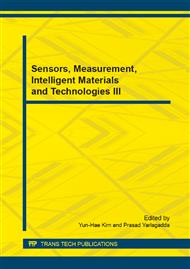[1]
Barry L. Zaret, M.D., Marvin Moser, M.D., Lawrence S. Cohen and M.D., in: Heart Book, Yale university school of medicine, pp.215-218, (1992).
Google Scholar
[2]
Riener, R., in: Technology of the Robotic Gait Orthosis Lokomat, Neurorehabilitation Technology, p.221, (2012).
DOI: 10.1007/978-1-4471-2277-7_13
Google Scholar
[3]
van Asseldonk, E.H.F. and H. van der Kooij, in: Robot-Aided Gait Training with LOPES, Neurorehabilitation Technology, p.379, (2012).
DOI: 10.1007/978-1-4471-2277-7_21
Google Scholar
[4]
Banala, S.K., S.H. Kim, S.K. Agrawal, and J.P. Scholz, in: Robot assisted gait training with active leg exoskeleton (ALEX), IEEE Transactions on Neural Systems and Rehabilitation Engineering, 17(1), pp.2-8, (2009).
DOI: 10.1109/tnsre.2008.2008280
Google Scholar
[5]
Unluhisarcikli, O., M. Pietrusinski, B. Weinberg, P. Bonato, and C. Mavroidis, in: Design and control of a robotic lower extremity exoskeleton for gait rehabilitation, 2011 IEEE/RSJ International Conference on Intelligent Robots and Systems (IROS), (2011).
DOI: 10.1109/iros.2011.6094973
Google Scholar
[6]
Özer Ünlühisarcikli, in: Human-robot interaction control of neurorehabilitation robots, Mechanical Engineering Dissertations. Paper 38. http: /hdl. handle. net/2047/d20002931, (2012).
Google Scholar
[7]
Duschau-Wicke et al, in: Robert Riener Patient-cooperative control increases active participation of individuals with SCI during robot-aided gait training, Journal of NeuroEngineering and Rehabilitation 2010, 7: 43 http: /www. jneuroengrehab. com/content/7/1/43, (2010).
DOI: 10.1186/1743-0003-7-43
Google Scholar
[8]
Baptista, L., in: Adaptive force and position control of robot manipulators, PhD Thesis, Technical University of Lisbon, Mechanical Engineering Department, Lisbon (in portuguese), (2000).
Google Scholar
[9]
Baptista,L., Ayala Botto, M. ect., in: A predictive force control approach of robot manipulators in nonrigid environments. International Journal of Robotics and Automation, 15(2) pp.94-102, (2000).
Google Scholar


